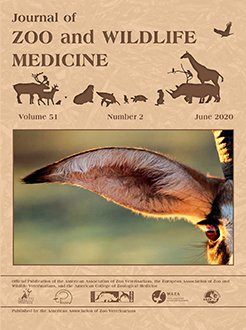Systemic isosporosis (formerly atoxoplasmosis), is a protozoal infection that causes death in nestling and fledgling passerine birds impacting ex situ breeding and reintroduction programs. Because current antemortem diagnostic tests lack sensitivity, a qPCR was developed for detection of Isospora spp. using primers and a fluorescent-tagged MGB probe targeting the large subunit (28s) ribosomal RNA gene (assay efficiency = >100%; sensitivity = <1 dsDNA copy). The assay was used to screen postmortem frozen or formalin-fixed paraffin-embedded tissue samples from passerine birds (n = 24; 12 with confirmed systemic isosporosis), whole blood and feces (n = 38) from live passerines, and other tissues infected with phylogenetically similar protozoa. The qPCR identified Isospora sp. DNA in tissues from 21/24 birds including 12/12 birds with cytologically-histologically confirmed infection (100% sensitivity) and 9/12 birds lacking microscopic organisms. The assay also amplified Eimeria sp. DNA; however, sequence analysis ruled out infection in the passerine cases. Blood and/or feces were positive in 30/38 birds, and in only 7/38 birds, blood and feces both contained Isospora sp. DNA. Finally, the qPCR was utilized to screen 30 consecutive daily fecal samples from live passerines (n = 20) to determine optimal sampling protocols. One or more of the daily fecal samples were positive in all 20 birds. In individual birds, the interval between positive qPCR amplification results ranged from 0 to 23 days, with an average of 5.85 days. Simulated application of 13 potential sample collection schedules was used to identify the sensitivity of repeated testing for identification of infected birds. Increased sampling days resulted in higher sensitivity but increased both cost and animal handling requirements. Based on statistical analysis and clinical considerations, the testing recommendation for detection of fecal shedding was collection and assay of five consecutive daily fecal samples, which had an average diagnostic sensitivity of 0.86.
How to translate text using browser tools
12 June 2020
A QPCR ASSAY AND TESTING GUIDELINES FOR THE MOLECULAR DIAGNOSIS OF SYSTEMIC ISOSPOROSIS (FORMERLY ATOXPLASMOSIS) IN PASSERINE BIRDS
Jennifer A. Landolfi,
Michael J. Adkesson,
Nadia Ahmed,
Carmen R. Smith,
Rebecca L. Smith,
Tim Snyder,
Karen A. Terio
ACCESS THE FULL ARTICLE
atoxoplasmosis
diagnosis
isosporosis
passerine
qPCR
systemic Isospora





